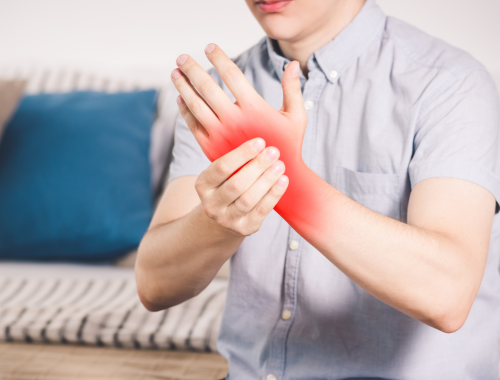Difference Between Cubital Tunnel Syndrome and Carpal Tunnel Syndrome
Cubital Tunnel Syndrome is the entrapment of the ulnar nerve at the Cubital fossa in the elbow. Carpal tunnel syndrome is a condition that occurs due to median nerve entrapment at the level of the wrist. It causes pain, and paresthesia particularly in the thumb, and adjacent two-and-a-half fingers.

What is Cubital Tunnel Syndrome?
Definition:
Cubital Tunnel Syndrome is the entrapment of the ulnar nerve at the Cubital fossa in the elbow.
Causes:
Possible causes of Cubital Tunnel Syndrome include pressure at the ulnar nerve due to compression as in armrest, repeated snapping of the nerve, overstretching of the nerve, and thickening of the muscles near the Cubital fossa.
Risk factors:
Risk factors of having Cubital fossa include having arthritis or bony spurs in the elbow joint, elbow dislocation, edema of the elbow joint, or any fractures involving the joint.
Symptoms:
Symptoms of Cubital Tunnel Syndrome include numbness and tingling of the fingers that is occasional and pain in the elbow joint.
Diagnosis:
Diagnosis of Cubital Tunnel Syndrome is made after history, examination, and investigation results such as blood sugar levels, thyroid hormones, electromyogram, and X-ray elbow joint.
Treatment:
Noninvasive treatment options for Cubital Tunnel Syndrome include taking nonsteroidal anti-inflammatory drugs (NSAIDs), wearing braces or splints, hand exercises, and physiotherapy. Surgical treatment includes procedures like ulnar nerve anterior transposition, Cubital Tunnel release, and medial epicondylectomy.

What is Carpal Tunnel Syndrome?
Definition:
Carpal tunnel syndrome is a condition that occurs due to median nerve entrapment at the level of the wrist. It causes pain, and paresthesia particularly in the thumb, and adjacent two-and-a-half fingers.
Causes:
Swelling, cellulitis, or edema in the wrist can cause median nerve compression resulting in carpal tunnel syndrome.
Risk factors:
Females are more commonly affected by carpal tunnel syndrome than males. The condition can be genetic as well. Pregnancy also increases the risk of getting carpal tunnel syndrome. Other conditions that can lead to the syndrome include wrist fractures, joint deformities, hand deformities, hypothyroidism, diabetes, and alcoholism.
Symptoms:
Carpal tunnel syndrome causes tingling and paresthesia, particularly in the thumb, index finger, middle finger, and half of the ring finger. Tasks like holding objects, writing, and typing are affected by the condition.
Diagnosis:
Tinel’s test helps in the diagnosis of carpal tunnel syndrome. As the test is performed, median nerve tapping produces wrist flexion and paresthesia in the fingers. Other important investigations for diagnosis include X-ray wrist, electromyography, and nerve conduction studies.
Treatment:
Treatment of carpal tunnel syndrome includes the use of NSAIDs, corticosteroid injections, and surgery which involves the resection of the transverse carpal ligament at the level of the wrist to reduce the edema.
Difference between Cubital Tunnel Syndrome and Carpal Tunnel Syndrome
Definition:
Cubital Tunnel Syndrome is the entrapment of the ulnar nerve at the Cubital fossa in the elbow. Carpal tunnel syndrome is a condition that occurs due to median nerve entrapment at the level of the wrist. It causes pain, and paresthesia particularly in the thumb, and adjacent two-and-a-half fingers.
Causes:
Possible causes of Cubital Tunnel Syndrome include pressure at the ulnar nerve due to compression as in armrest, repeated snapping of the nerve, overstretching of the nerve, and thickening of the muscles near the Cubital fossa. Swelling, cellulitis, or edema in the wrist can cause median nerve compression resulting in carpal tunnel syndrome.
Risk factors:
Risk factors of having Cubital fossa include having arthritis or bony spurs in the elbow joint, elbow dislocation, edema of the elbow joint, or any fractures involving the joint. Females are more commonly affected by carpal tunnel syndrome than males. The condition can be genetic as well. Pregnancy also increases the risk of getting carpal tunnel syndrome. Other conditions that can lead to the syndrome include wrist fractures, joint deformities, hand deformities, hypothyroidism, diabetes, and alcoholism.
Symptoms:
Symptoms of Cubital Tunnel Syndrome include numbness and tingling of the fingers that is occasional and pain in the elbow joint. Carpal tunnel syndrome causes tingling and paresthesia, particularly in the thumb, index finger, middle finger, and half of the ring finger. Tasks like holding objects, writing, and typing are affected by the condition.
Diagnosis:
Diagnosis of Cubital Tunnel Syndrome is made after history, examination, and investigation results such as blood sugar levels, thyroid hormones, electromyogram, and X-ray elbow joint. Tinel’s test helps in the diagnosis of carpal tunnel syndrome. As the test is performed, median nerve tapping produces wrist flexion and paresthesia in the fingers. Other important investigations for diagnosis include X-ray wrist, electromyography, and nerve conduction studies.
Treatment:
Noninvasive treatment options for Cubital Tunnel Syndrome include taking nonsteroidal anti-inflammatory drugs (NSAIDs), wearing braces or splints, hand exercises, and physiotherapy. Surgical treatment includes procedures like ulnar nerve anterior transposition, Cubital Tunnel release, and medial epicondylectomy. Treatment of carpal tunnel syndrome includes the use of NSAIDs, corticosteroid injections, and surgery which involves the resection of the transverse carpal ligament at the level of the wrist to reduce the edema.
Table of differences between Cubital Tunnel Syndrome and Carpal Tunnel Syndrome

FAQs
How can you tell the difference between Carpal Tunnel and Cubital Tunnel?
Carpal Tunnel Syndrome causes tingling or paresthesia of the thumb, index, and middle finger whereas Cubital Tunnel Syndrome affects the ring and little finger.
What are the stages of Cubital Tunnel Syndrome?
Stages of Cubital Tunnel Syndrome include mild, moderate, and severe paresthesia.
Which fingers go numb with Cubital Tunnel Syndrome?
Cubital Tunnel Syndrome affects the ring and little finger.
Can you have Carpal and Cubital Tunnel Syndrome at the same time?
Yes, very likely.
What makes the Cubital Tunnel worse?
Compression of the elbow or bending of the elbow for a long time can make the Cubital Tunnel worse.
Why is the Cubital Tunnel worse at night?
People sleep with elbows bent and this can worsen Cubital Tunnel Syndrome.
Palmer, Bradley A., and Thomas B. Hughes. “Cubital tunnel syndrome.” The Journal of hand surgery 35.1 (2010): 153-163.
- Differences Between Reptiles and Amphibians - May 17, 2024
- Difference Between Ophthalmology and Optometry - May 15, 2024
- Difference Between Fear and Anxiety - April 2, 2024
Search DifferenceBetween.net :
Leave a Response
References :
[0]De Krom, M. C. T. F. M., et al. "Risk factors for carpal tunnel syndrome." American journal of epidemiology 132.6 (1990): 1102-1110.
[1]Werner, Robert A., and Michael Andary. "Electrodiagnostic evaluation of carpal tunnel syndrome." Muscle & nerve 44.4 (2011): 597-607.
[2]Palmer, Bradley A., and Thomas B. Hughes. "Cubital tunnel syndrome." The Journal of hand surgery 35.1 (2010): 153-163.
[3]Image credit: https://www.canva.com/photos/MAE4Ohmc3jc-sick-man-wearing-white-t-shirt-sitting-on-cough-in-living-room-touching-painful-shoulder-suffering-trauma-sprain-wrist-feeling-ache-of-carpal-tunnel-syndrome-/
[4]Image credit: https://www.canva.com/photos/MADDKgGt-nk-pain-in-hand-man-suffering-from-carpal-tunnel-syndrome-at-home/
